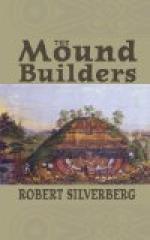Mounds.—I stated at the outset that the mounds in Ohio were very numerous. They are of various sizes, ranging from those which are only a few feet in height and a few yards at their base, to those which are about 90 feet in height, and covering some acres at their base. These mounds are mostly composed of earth, the material often differing greatly from the surrounding soil. When we consider the multitudes of these mounds, and the immense transportation of earth and stones required in their structure, it needs no stretch of imagination to conclude that the Mound-builders were a mighty race. Most of these mounds are located near large rivers or streams, and, consequently, in the valleys, although some few are to be found on high lands, and even on hills very suitable for military purposes. Sometimes they may be seen in clusters, indicating a great business centre and large population, while again only one may be found in a journey of fifty or one hundred miles.
During the last fifty years, these tumuli have been carefully examined, and, from their contents, shape and position, they are now classified as Temple or Sacrificial Mounds, Burial or Sepulchral Mounds, Symbolic Mounds, Signal Mounds and Indefinite Mounds. I shall briefly describe the characteristic of each class and give a few examples.
Temple Mounds.—These mounds are not so numerous in Ohio as in some other States, yet they occur in sufficient numbers to deserve a small share of our attention. The city of Marietta has slowly encroached upon some interesting remains of a sacrificial character, which consist of two irregular squares containing 50 and 27 acres respectively. They are situated on a level plain 100 feet above the level of the Ohio and Muskingum Rivers. The smaller square has ten gateways, which are covered by mounds, while the larger square, being strictly a sacred enclosure, has no mounds to cover the 16 openings, but contains nevertheless four temple mounds of considerable interest. On the top of these mounds, doubtless there were erected capacious temples, as there are significant avenues of ascent. There may still be seen the remains of the ancient altar, where, without doubt, these people assembled for worship, and where, from the presence of human bones, we may conclude human beings were offered in sacrifice. In all the sacred enclosures, evidences of altars have been found, on which, doubtless, the sacrificial fires blazed for ages. Often are to be found successions of alternate layers of ashes and blue clay, indicating a desire for pure sacrifice.
In the neighborhood of Newark, Ohio, at the forks of Licking River, may be seen most elaborate enclosures, square, circular, and polygonal in their form, covering in all an extent of four square miles. Like the ancient temples of the Druids, most of the enclosures have their openings to the east, or rising sun, so that the first rays shall strike the altar where doubtless a priest, from the early hour of dawn, performed mysterious rites.




